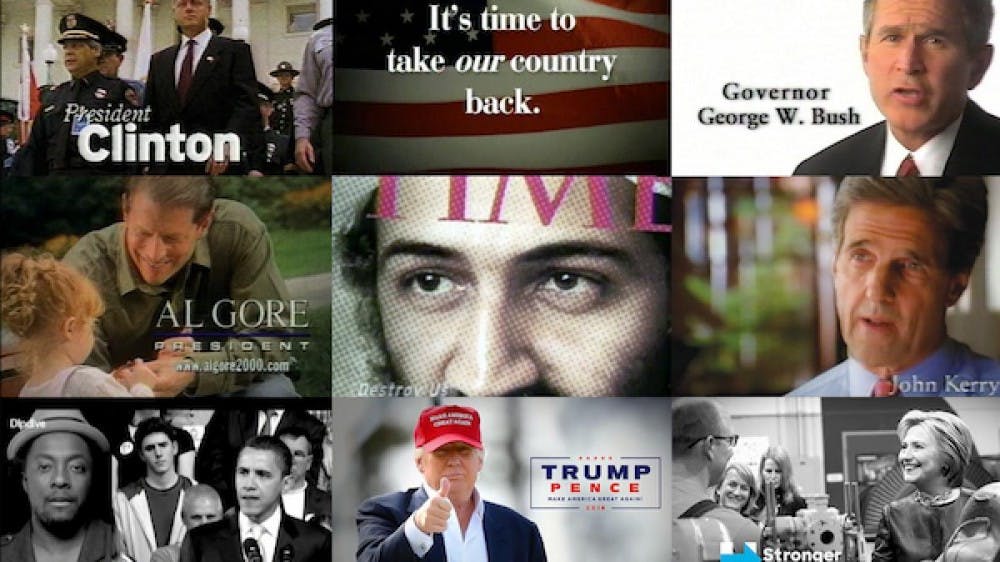In every presidential election, there are a variety of political advertisements in favor or against each candidate on TV, radio, embedded within social media and plastered in our neighbors’ front yards. But behind these advertisements is an art form, and one that artists Antoni Muntadas and Marshall Reese are truly passionate about.
The director of the ASU Art Museum, Gordon Knox, has worked with Muntadas and Reese before and praised them as “elegant and sophisticated thinkers, brilliant artists with a great sense of aesthetics ... who create new ways of thinking.”
On Tuesday, Nov. 1 from 5:30 to 7:30 p.m. at the ASU Art Museum in Tempe, Muntadas and Reese will present their viewing of “Political Advertisement IX 1952-2016” to the public. This special event is one that has been viewed all over the United States and Canada in museums, theaters and even the ASU Art Museum four years ago during the 2012 presidential election.
This combination of untouched footage is a compilation of political advertisements from the past nine presidential elections, starting with Republican Dwight D. Eisenhower vs. Democrat Adlai E. Stevenson and ending with Republican Donald Trump vs. Democrat Hillary Clinton.
This is a single piece of artwork that has been constantly updated for 32 years, but Muntadas and Reese have no intention of stopping their project, not even after three decades.
“I can't imagine that we stop unless there ceases to be elections, health problems, or one of us disappears,” Reese said.
When they started the project in 1984, it was difficult to obtain access to political footage. Before social media and the concept of YouTube, Muntadas and Reese used their creativity to hunt down the necessary resources. Most of the political advertisements were recorded on VHS tapes, and some footage was provided directly by the campaigns. It helped to have friends in the television industry.
In order to build their archive, Muntadas and Reese carefully select each scene and are “conscious of the narrative art,” Reese said.
The draw of political advertisement
Both Reese and Mark Thompson, an ASU junior majoring in filmmaking practices, agree that the way media markets politicians has a vast influence on politics. Thompson is constantly surrounded by advertisements as an average consumer and because of his interest in filmmaking.
“I think (advertisements) have an impact on the election and the process,” Thompson said. “Without the ads, there really wouldn't be much to talk about.”
He pointed out that political ads spark conversation most often because of their controversy, referring specifically to actor Robert De Niro’s recent remarks about Trump in the #VoteYourFuture campaign.
“Politicians are advertised like products, and this is what fascinates us,” Reese said.
At the end of each viewing, Muntadas and Reese discuss the film with other professionals and those who attend the event. The discussion is open to the public and will include both of the artists and Daniel Rothenberg, the co-director of the Center on the Future of War and professor of practice for the ASU School of Politics and Global Studies.
Arizona’s political and artistic engagement
Over the past couple of years, Muntadas and Reese have formed a good relationship with ASU and specifically with director Gordon Knox, which is one of the reasons they show their film in Arizona. When presenting “Political Advertisement” to the public, Muntadas and Reese specifically choose states that are receiving current political attention like Pennsylvania, Ohio, New York, Florida and now Arizona.
“Arizona is becoming an important state electorally,” Reese said. "There is a huge demographic shift, and it seems that what we are doing has interest here.”
When it comes to these mediums, Knox said he believes that art and politics have a lot more in common than most people think.
“(Politics and art) are sort of parallel, but they also have cross-purposes,” Knox said. “Art is about challenging the status quo, politics is about reestablishing the status quo.”
ASU’s support for creative thinking
Knox said he is impressed by Muntadas and Reese’s artwork and its ability to connect with a mass public audience. Knox said ASU is far ahead in the realm of innovation, technology and overall creative thinking, making it a unique place for artists like Muntadas and Reese to share their work.
“(ASU) is the most innovative school in the country,” Knox said. “It is the kind of work that these two artists do and completely the type of work that the museum is proud to present.”
Visit the ASU Art Museum’s website for more information on “Political Advertisement IX 1952-2016,” or other exhibits featured there.
Correction: Due to a reporting error, a previous version of the article incorrectly identified the candidates of the 1956 presidential election. The race was between Dwight D. Eisenhower and Adlai E. Stevenson, not Dwight D. Eisenhower and Richard Nixon. The article has been updated with the correct information.
Reach the reporter at lhgoldbe@asu.edu or follow @leahxgoldberg on Twitter.
Like The State Press on Facebook and follow @statepress on Twitter.




